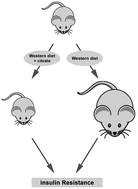Citrate enrichment in a Western diet reduces weight gain via browning of adipose tissues without resolving diet-induced insulin resistance in mice†
Abstract
Citrate, a major component of processed foods, appears as either preservative or flavor enhancer. With no concentration limit, citrate is consumed in large quantities worldwide, principally in ultra-processed foods (UPF). UPF are encountered in Western diets (rich in saturated fat and sucrose), where consumption is directly associated with many conditions, such as obesity and diabetes, among others. Here, we administered a High-Fat, High-Sucrose (HFHS) diet to mice, enriched or not with citrate (67 mg g−1 diet), aimed to simulate UPF citrate consumption. Our results showed that citrate enrichment prevented the HFHS-induced lipid deposition in the liver and adipose tissues of the animals. Moreover, the treatment induced mitochondrial biogenesis in white adipose tissues, via upregulation of PCG1α. As a result, citrate enhancement upregulated UCP1, suggesting the browning of white adipose tissues. Nevertheless, the citrate-enhanced diet did not prevent HFHS-induced insulin resistance and causes further liver inflammation and injury. Altogether, our results clearly showed that, associated to UPF consumption, the excess of dietary citrate has caused harmful effects being associated to non-obesity related liver inflammatory diseases and insulin resistance.

- This article is part of the themed collection: Food & Function HOT Articles 2022


 Please wait while we load your content...
Please wait while we load your content...